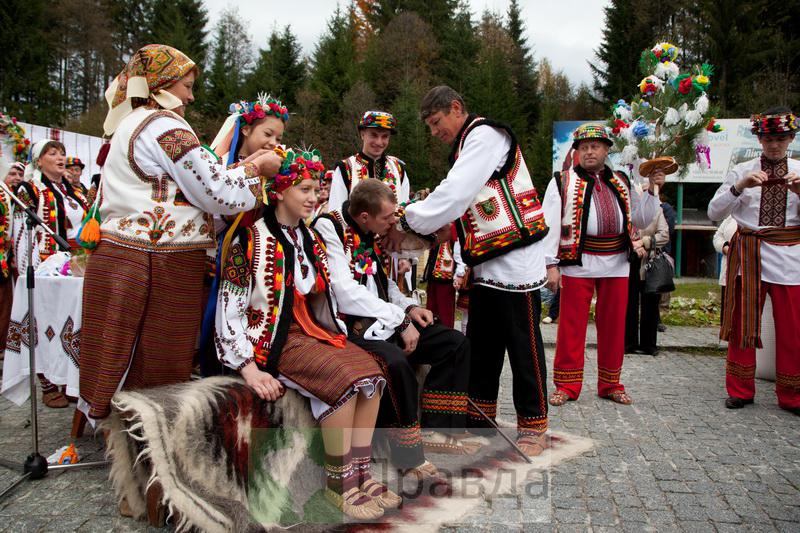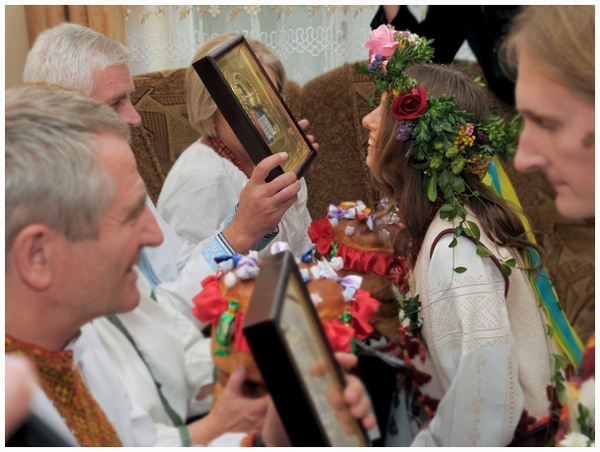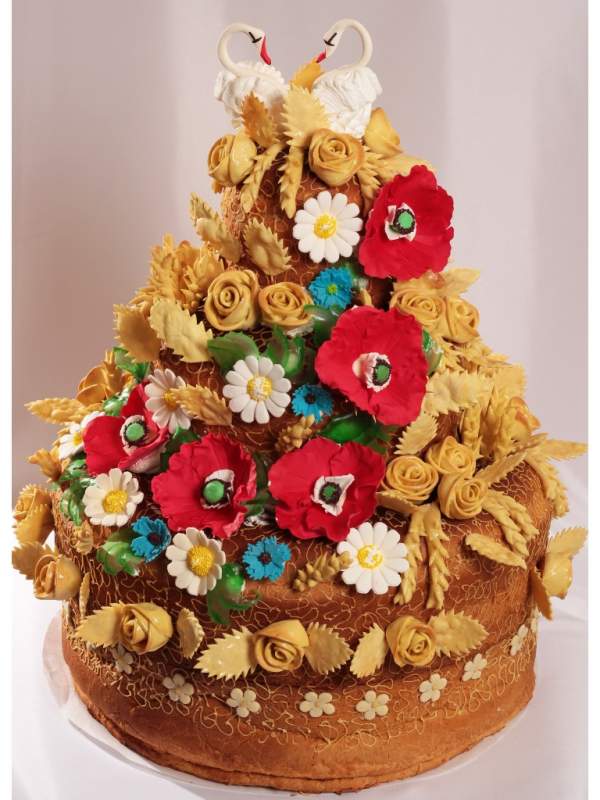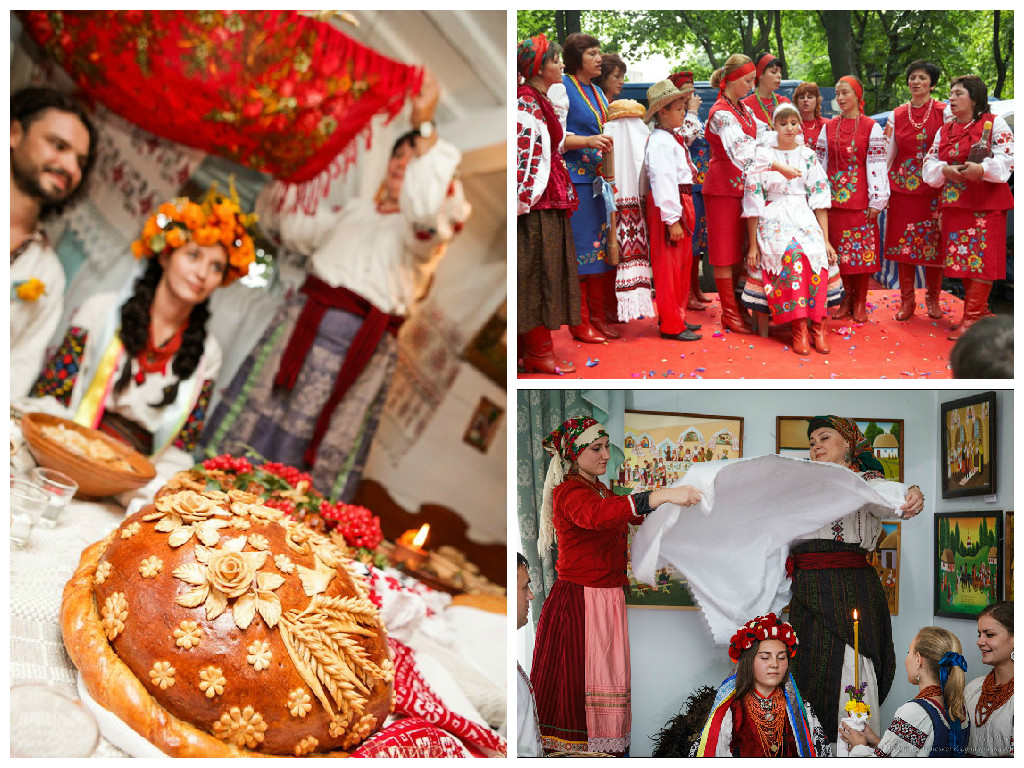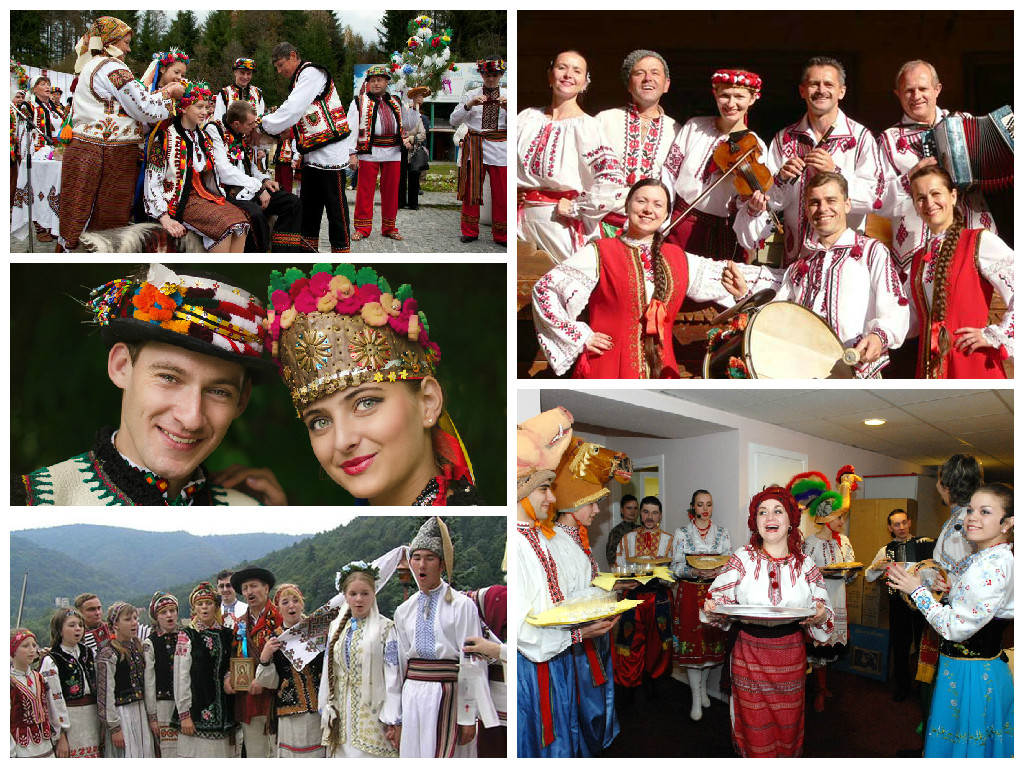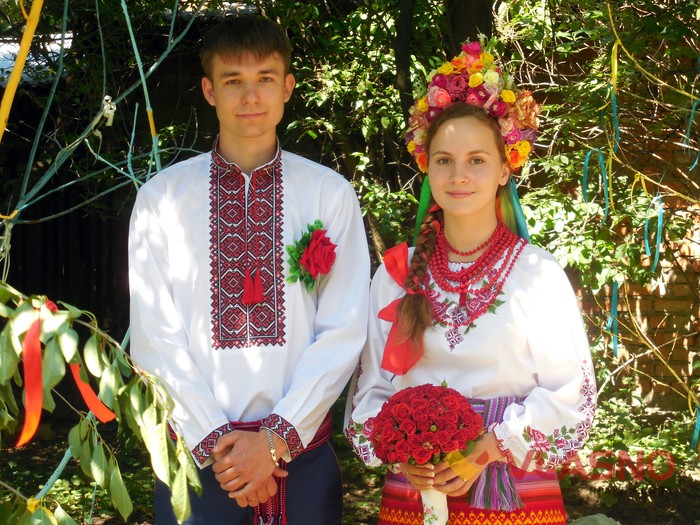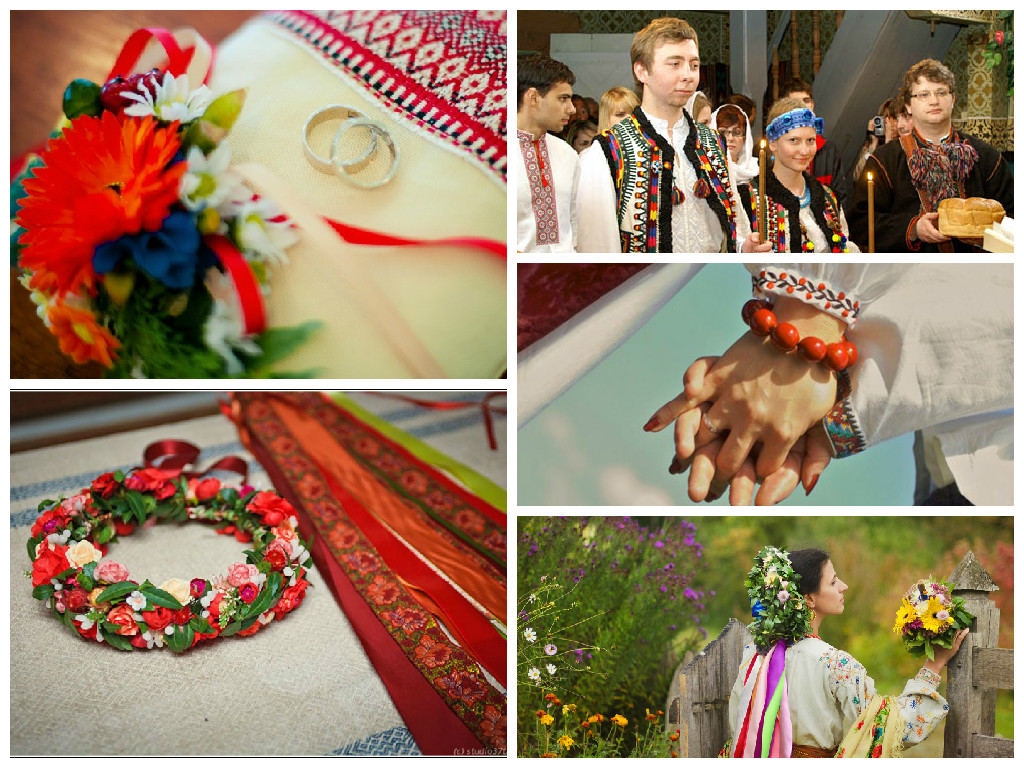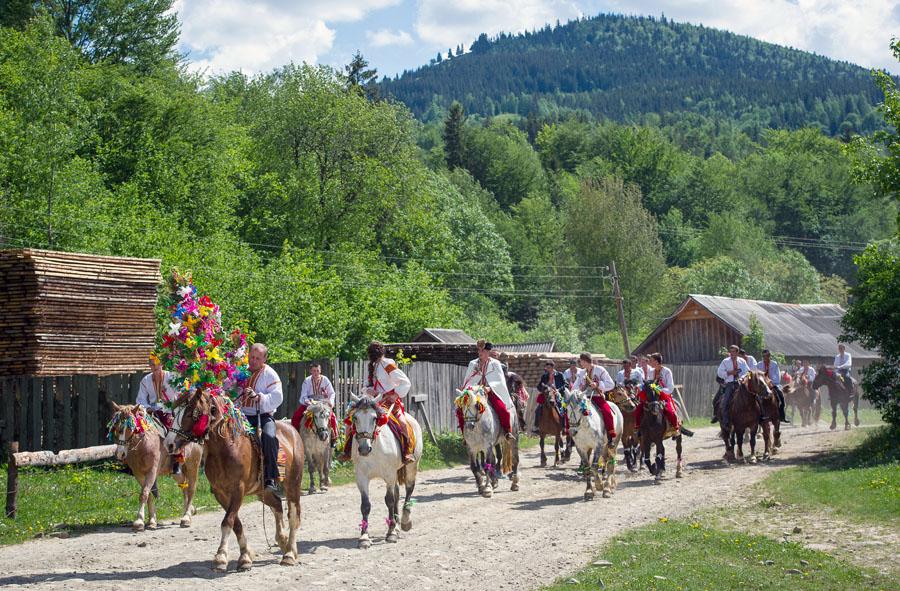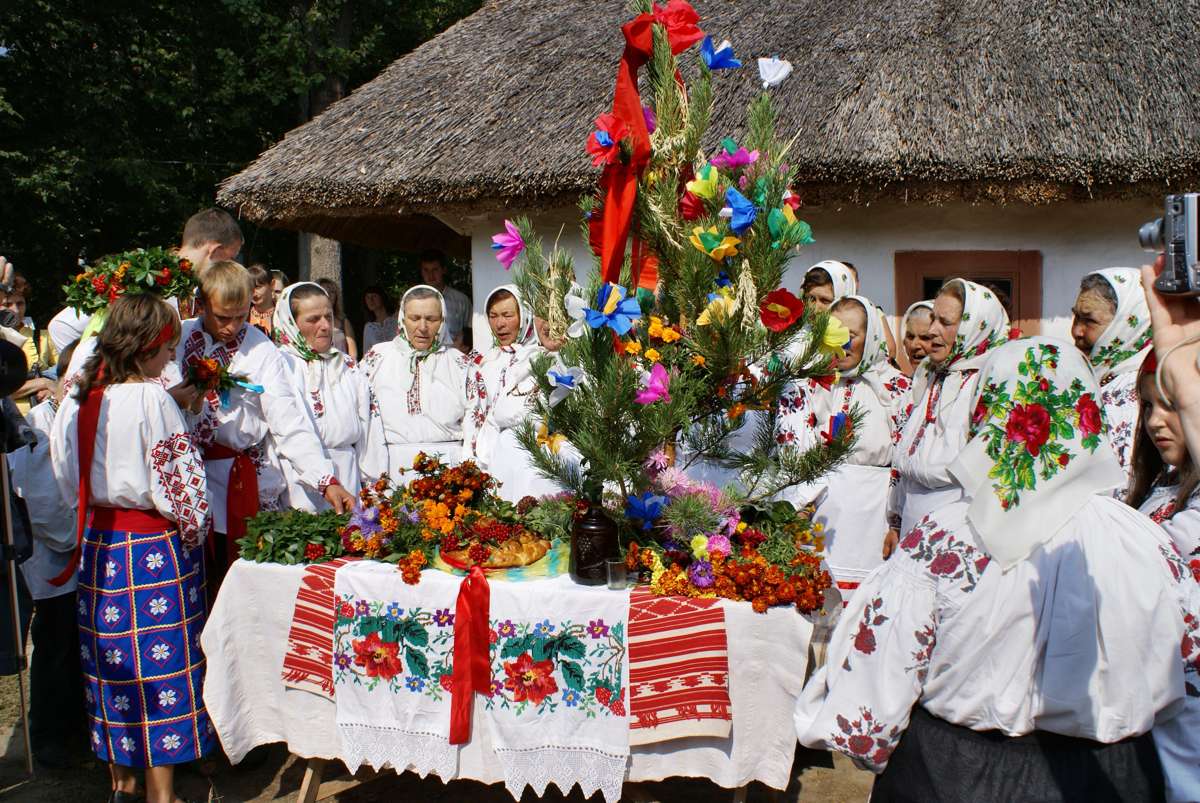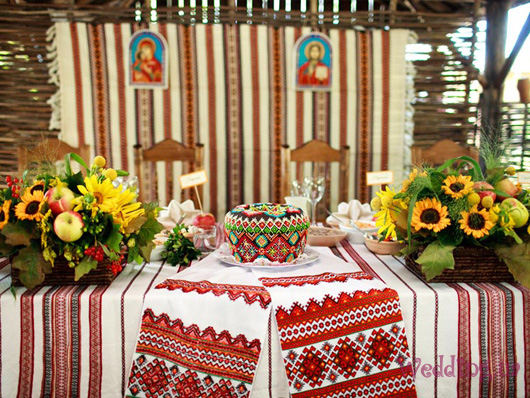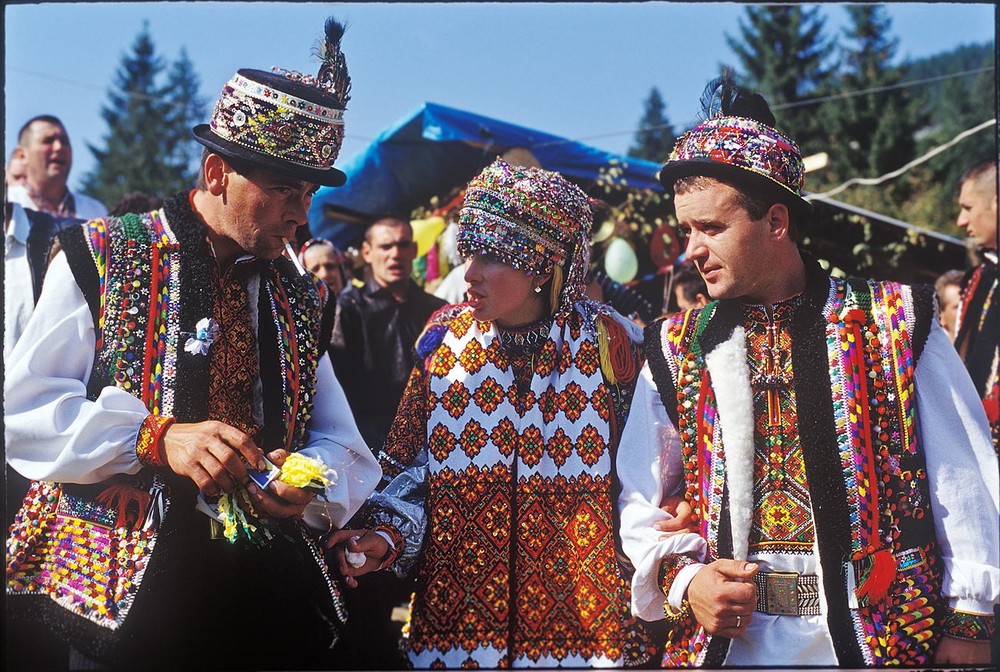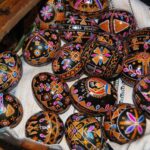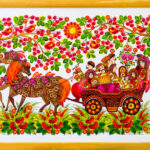The Ukrainian Wedding is one of the most symbolic celebrations of Ukraine culture. Traditions and customs for Ukrainian weddings are numerous and have evolved through the ages. National traditions are dominant in Ukrainian wedding ceremonies. Some of them are very old and difficult to explain.
Over time things change, people and their preferences change, lifestyles and of course – one of the most important events in life “marriage” will change as well.
The most important wedding customs and rituals that were honored by our ancestors are still in use. Some customs, such as “matchmaking” and “buying out the bride” are heavily modified in order to adjust to modern couples’ abilities. Other wedding rituals, such as the “betrothal” are performed strictly because of the religious connection to the wedding ceremony.
Understanding Ukrainian wedding events can be difficult, especially if you don’t speak the language. Foreign guests at Ukrainian weddings will have endless questions about certain things that are taking place.
Here you will find some priceless information on most of the traditions that you will likely experience during a wedding in Ukraine.
Buyout a Bride
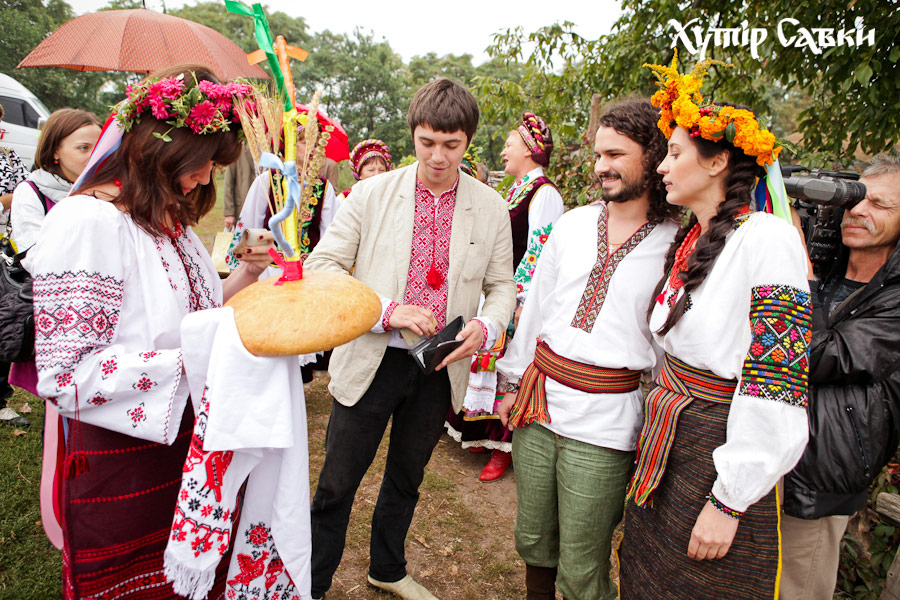 They are almost married! Groom just need to pick up the bride from her parents’ house and escort her to the church ceremony – which is called “crowning” in Ukraine. But understand, nobody in Ukraine is prepared to give the bride away with just a simple ‘thank you’. ..
They are almost married! Groom just need to pick up the bride from her parents’ house and escort her to the church ceremony – which is called “crowning” in Ukraine. But understand, nobody in Ukraine is prepared to give the bride away with just a simple ‘thank you’. ..
Attention: you already hear distant horns from the groom’s wedding cortege. Guests are scattering from their cars and in a minute, a procession headed by the groom is standing at the “gates”.
IT HAS BEGUN!
 The “Gates” refers to an area with a nice decorated table with some flowers and special table cloth. The table is located in front of the main entrance of the house where the bride resides. On the one side of table – bridesmaids, friends of the bride, and locals from the neighborhood wait in anticipation. At last the dialog of parties has started! The bride’s friends begin by asking the groom why exactly he came here today?! “To receive my bride” – he says proudly. Eventually the groom realizes that he can’t get the bride so easily. Because she, having all that beauty, kindness and thrift, is very precious for her family. The bride’s family will require the groom to acknowledge the bride’s sense of worth. The wise groom shall offer his full cooperation with the demands of the bride’s representatives. Such cooperation includes payment for the bride!
The “Gates” refers to an area with a nice decorated table with some flowers and special table cloth. The table is located in front of the main entrance of the house where the bride resides. On the one side of table – bridesmaids, friends of the bride, and locals from the neighborhood wait in anticipation. At last the dialog of parties has started! The bride’s friends begin by asking the groom why exactly he came here today?! “To receive my bride” – he says proudly. Eventually the groom realizes that he can’t get the bride so easily. Because she, having all that beauty, kindness and thrift, is very precious for her family. The bride’s family will require the groom to acknowledge the bride’s sense of worth. The wise groom shall offer his full cooperation with the demands of the bride’s representatives. Such cooperation includes payment for the bride!
And so the bargaining begins… The respective party of the bride proceeds to glorify and compliment her however they can, as to establish her high sense of worth. Meanwhile, the groom’s support group attempts to counter such actions with their own negotiating techniques, as to establish a more favorable price for the groom to pay. The groom will take a more passive role during this process. Yet he will be required to thoroughly describe his potential bride as he will be given the opportunity to express his love and admiration for her. The groom will also be given an opportunity to express his present and future intentions.
Eventually the two parties agree on price. It can be anything – champagne and candies, some money, or some other presents from the groom’s party. But the payment of material goods or money is not the only thing which awaits the friendly groom’s company. Bridesmaids could also prepare different tests for the groom and his best friends. For example, the groom may be asked to guess which one of the lipstick prints on the paper is from the bride. And if the groom doesn’t choose the right one – he either pays more, or faces another consequence.
And here it is – the long awaited moment! The doors open and the bride appears from within her home. But apparently – The groom is shocked! He is frightened and confused trying to understand how could he fall in love with this monster with such hairy legs and huge belly – and a mustache! He soon realizes that this bride is a fake. Such situation suggests that the size of the groom’s payment was too small and it should increased with money, or with some spirits and sweets.
The main point in whole this process is not to gain profit or presents from the groom, but to have fun learning and discovering about the groom and bride. If both parties are clever and creative enough, this experience will be enjoyable not only for local Ukrainians, but even for foreigners who might not be understanding of the actual language.
Ultimately, the process of bargaining should never take too long because the young couple must get to the church service and to RAGS (city hall) to register their marriage legally. If the negotiation will take too long, it may ruin the great festive mood for the bride and groom.
Careful planning of such details can save your special day.
Meanwhile, as both parties negotiate…
A long time ago, before giving the bride to the reliable hands of her future husband, she would have been dressed in a strict appropriate manner.
How long does it take? For example, Hutsuls (Carpathian Mountain natives) could spend three hours dressing the bride. Sure you will say that modern brides may take as much time with their preparations, with all those hairstyles and manicures. But understand that Hutsuls are not accustomed to elaborate cosmetic use, as they prefer a more natural look.
When dressing their brides, Hutsuls would beautify her with colorful embroidered shirts, a wide woven belt, handkerchiefs, a sheepskin coat, an embroidered necklace, and special shoes – red sandals. The bride’s hair would be beautifully braided and decorated with different flowers, ribbons and various small, red trinkets in which coins and cloves of garlic are hidden inside as a preventative measure against bad energies. The bride’s mother would also put a wreath on the head of her daughter, in which the bride cannot take off until the end of a wedding. This is performed as a blessing of good luck for the couple’s future.
Nowadays, the wreath is often replaced with bread given from the godparents. The bread will be decorated with a little wreath on top. It is customary for the bride to kiss the bread while kneeling.
But enough about Hutsuls… Modern traditions as you may know, are not so diferrent. The main difference being in the style of dress of the bride and groom. And of course, most don’t put garlic on their heads today!
While closest relatives are dressing the bride, she is sitting anxiously on a chair with a pillow. When the bride stands up and goes out to the groom, the bridesmaids compete against each other to be the first to fall on the pillow. The bridesmaid that falls on that pillow first – will be the first to become married herself.
So after the negotiations, the dressing of the bride, and the bridesmaids competing for the lucky pillow, the bride and groom finally unite. They are greeted by their godparents, who proceed to bless them with holy icons.
Parent’s Blessing
The loving couple is eager and ready to move on, but they must wait patiently. Parents and godparents of the bride and groom will bless them with wedding bread (korovai) and icons.
Don’t be surprised when you see when 5 or so couples of godparents approach and bless the wedding couple. Yes – They all are their godparents! In Ukraine it is popular to baptize a baby and have 2-10 couples of godparents for one child.
Now back to the blessing… The bride and groom stand in the room together and ask for the blessing from both parents. The parents will hold the icons while the prospective couple and parents make three bows while standing and facing each other. The same procedure is repeated with all couples of godparents. The last couple of godparents pass the icons to the bride and groom. The bride and groom then kiss the icons and hold them in their hands.
The wedding couple then proceeds to make their way towards the church or RAGS (according to plan).
Church Service
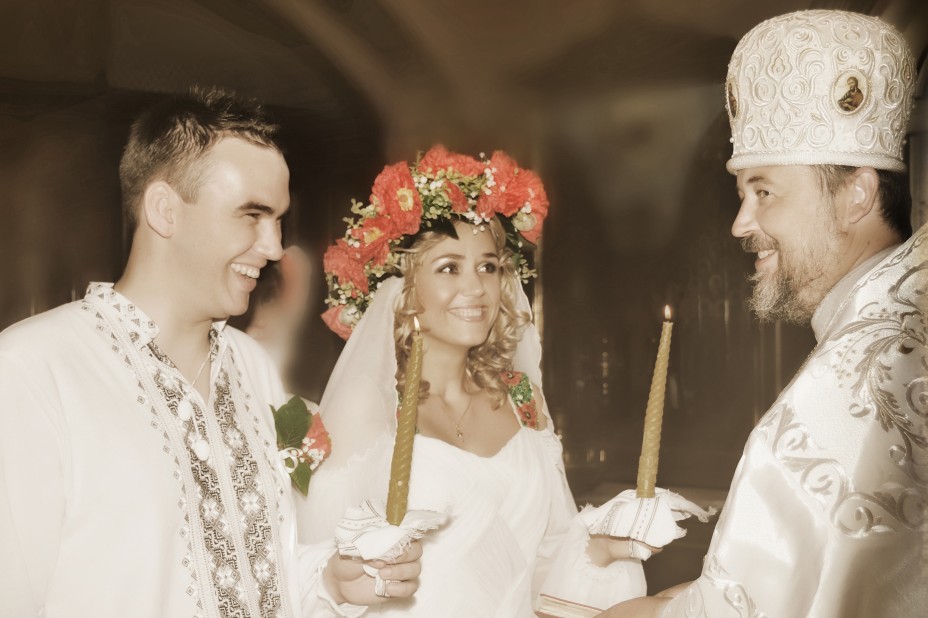 According to Christian practice, marriage takes place only when both husband and wife are willing to commit themselves to each other for eternity. Husband and wife both vow respect and eternal love. Such love is to be considered unconditional and only such love can be the foundation for the church wedding ceremony.
According to Christian practice, marriage takes place only when both husband and wife are willing to commit themselves to each other for eternity. Husband and wife both vow respect and eternal love. Such love is to be considered unconditional and only such love can be the foundation for the church wedding ceremony.
Orthodox recognizes marriage as a sacrament – and the ceremony of a wedding is basically the act of obtaining God’s blessing and special gift of love, which will combine two hearts forever.
Two people forever become one in soul and body during this ceremony.
The sacrament of marriage consists of two parts – “betrothal” and “wedding”. A long time ago these two rituals where separated with time. “Betrothal” followed engagement and could be terminated before the “wedding”.
During the “betrothal”, the priest gives the couple two burning candles, as a symbol of joy and warmth. He then puts the rings on – first the groom, and then on the bride.
After the “betrothal”, the couple then goes to the center of the church. The priest asks them if they are free and if they have been faithful to their commitment to each other. The producers of Hollywood movies at this moment like to add a third person to the stage – some kind of forgotten spouse or someone’s miserable lover. But these kind of things are only for melodramas, such events rarely happen.
As with any other ritual, the ritual of “marriage” is very symbolic. During this process, the bridesmaids and groom’s best friends hold crowns above the heads of the groom and bride. We understand that this may sound very new to you, as you probably have never heard of such experience before. To help you better understand what “crowns” are and why they are placed above the couple’s heads, we post some pictures here to assist.
The “crowns” are very sacred objects. And people who hold them in their hands, should use a handkerchief, and never touch the crown with bare hands – this is forbidden by the church.
If you translate Ukrainian “church marriage ceremony” literally – you will have “Crowning” (yes, sounds like crowning of kings and queens, but don’t forget – this is Ukraine with its ancient history and breathtaking rituals).
The Crowns, which are held above the head of the prospective couple, symbolize the Crown of Kingdom of Heaven. The chalice of wine, from which the priest provides communion to the couple, is a symbol of life chalice representing joy and sorrow in which the couple would share until the end of their days.
According to traditions, the prospective couple shouldn’t eat anything before the ceremony, and the wine from the chalice will be their first drink from the start of the day. So right away after their first sip, they will feel real warmth and happiness, as they are likely to experience a most comforting sensation.
Also, there is a moment when the priest binds the hands of bride and groom with an embroidered towel. While holding their hands, he asks the couple to follow him three times around the altar. This circular path created around the altar, symbolizes that the sacrament of “marriage” will be eternal.
The marriage ceremony is one of seven sacraments. It is understood that such a sacred act is not fully shared with others. Other people cannot witness what the soul of the bride or groom is going through during their ritual. Before the sacrament of marriage, the couple should confess in front of God and take Holy Communion. Accordingly, the day before the wedding the couple should obstain from any alcoholic drinks or smoking. In some cases, the priest may also instruct the couple not to eat meat dishes (to lent).
It is important to understand that the “marriage” sacrament must be performed in church on certain days.
Korovai (Wedding Bread)
Let’s not forget about important details such as wedding Korovai! If you start exploring wedding traditions of different nations, you will find out that every nation has a tradition of having some kind of special bread for the wedding. Ukrainians, who are known to possess the planet’s most fertile soils and bountiful wheat crops, aren’t the only ones to honor such bread traditions. This special bread has different names in different countries. Ukrainian wedding bread bares the proud name – Korovai.
Let’s talk about the history of Korovai.
Wedding bread “Korovai” is not just any bread served at the wedding table. It looks like a big cake, which may have from 1 to 5 tiers, decorated with unleavened dough, marshmello or whipped eggwhite (meringue). This bread accompanies the prospective couple from the very beginning of their wedding day and is shared among the guests at the end of the party. Let’s say, that it is something like american tradition of wedding cake, but Ukrainian Korovai has much more purpose than for providing a tasty treat.
The preparing of Korovai is one of the most common wedding rituals amongst Ukrainians, which symbolizes the blessing the community gives to the wedding couple. In different regions of Ukraine, this ritual may slightly differ. The main wedding bread has been designed according to a certain theme/scenery. The process of making Korovai should have been started on the Friday or Saturday before the wedding day at the bride’s or groom’s house. Members of both families should participate in the ritual as a symbol of families connecting.
In Ukraine, it is common to have women who are married making Korovai. The nesessary condition is – women should be in their first marriage and have happy family life. Participation of widows is frowned upon(dissallowed). There is a superstition that women who make the wedding bread, will give a piece of their fate to the prospective couple.
The baking of Korovai is accompanied by various ritualistic actions. For example, women who would be making the dough would be bound with a special embroidered towel and their hands would be washed with holy water. The process of making dough should flow with a good mood of bakers. When the dough is ready, one of the women would make the sign of the cross on top of the oven showel, on the oven, and on the bread itself. Only after silent prayer would the Korovai enter the hot oven with the utmost care.
The family anticipates that the bread will come out nice and baked even – without any cracks on top and on the sides. There is a common belief among Ukrainian people that twisted bread is a sign of bad luck for the prospective couple, and the cracked bread signifies divorce. Women, who are baking wedding bread believe, that to prevent unwanted results they should work with the bread in a cheerful and happy mood – fast and proffesional without any hesitations.
The Korovai is present at all wedding events from the beginning to the end. When the loving couple goes to the church to obtain the blessing of God for their future life, the Korovai is taken with them. During the entire ceremony it takes its respectful place close to the altar. After the church service, Korovai is taken to the place where the couple will celebrate their marriage; to the reception where it is placed in a highly visible location. At the end of the celebration, Korovai is divided among all guests. The closest relatives of the bride, married men, would have a respectful role of cutting it and offering it to guests.
Wedding Icons
During the sacrament of marriage, the priest will bless the couple for a long and happy life together. The groom receives such blessing with the icon of “Jesus Christ”, and the bride receives the blessing with the icon of “Holy Mother of God”. Those two icons are specifically referred to as – wedding icons (matrimonial icons).
When purchasing wedding icons, pay attention to their content. It is necessary that one icon should have the image of Jesus Christ (adult image), and the other icon should have a picture of the Holy Mother of God. In many religious stores, marriage icons are often prearranged in pairs . The size and price of the icons is not important. The prospective couple should choose what they think is appropriate. It is very important that both icons are not connected, as they should be held separately by the couple.
The priest should bless the set of icons with holy water at least a week before the actually ceremony. If you buy icons from a church store, it is possible that they are already blessed.
A long time ago wedding icons were traditionally passed from parents to their children. Performing a wedding ceremony with the parents’ icons could offer a powerful blessing, considering that the parent’s marriage was healthy and successful. During times of USSR communistic rule, people were not allowed to visit holy places and churches. People were also forbidden to possess holy icons and religious artifacts. Many church’s and religious items were purposely destroyed by the communist government. As a result, very few parents of modern couples were able to experience holy matrimony in church.
Wedding Embroidery
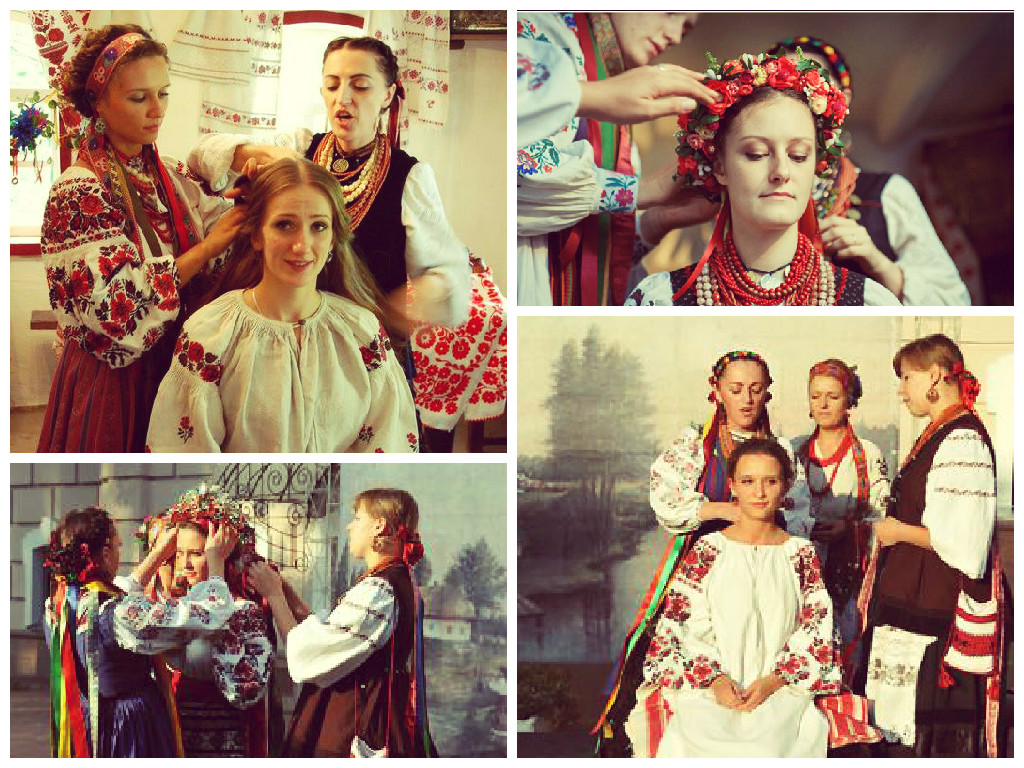 Traditional Ukrainian embroidery is well known for its exquisite beauty and complex patterns. A variety of authentic embroidery plays a significant role in an Ukrainian wedding ceremony. Wedding bread(Korovai) and authentic embroidery is of traditional importance and, signifies the national character.
Traditional Ukrainian embroidery is well known for its exquisite beauty and complex patterns. A variety of authentic embroidery plays a significant role in an Ukrainian wedding ceremony. Wedding bread(Korovai) and authentic embroidery is of traditional importance and, signifies the national character.
Here we will explain to you exactly why embroidered towels have such a large role in wedding traditions. We will also discuss how to correctly prepare the embroidered towel for the wedding rituals.
From ancient times, towels symbolized a form of protection. The specific energies within the embroidery are characterized according to the specific patterns, colors, and placement of key elements.
The embroidered towel “formulates” the future life of the family. These sacred stitches contain specific wishes and expectations for the future, brought forth through good intentions from the hands of the towel’s creator. The power of such ritual is conditional – the person, who creates the towel’s embroidery should be acquainted with the meaning of certain symbols used. The individual should be kind and friendly, and provide the artwork with the best of intentions.
The bride should make an embroidered towel by herself, because noone wishes the future family more success than the actual bride. By ordering the wedding towel from somebody else, the bride risks the possibility of introducing the thoughts and wishes of others into the future life of her family. Such intentions are not always good. Even while making the embroidered towel by herself, the bride should be careful. She should not allow negative thoughts or a bad mood to influence the process. If you have a bad mood or have distressed feelings, it is better to defer the work and wait for a better and more peaceful mood.
The choice of fabric used for the wedding towel is very important. The towel should consist of one solid piece of fabric, never from several pieces which are sewn together… ” like fate, which moves ever forward, never to be interrupted.”
According to ancient canon of embroidery towels, each towel is divided into three approximate even parts. Both end portions should contain embroidery, and the middle of the towel should always remain untouched. The middle part of the towel, which is without embroidery, symbolizes the purity of God’s kingdom. One should remember this when choosing templates for embroidery. If ignored, positive intentions are disregarded and this may alter the fate, and may become dangerous to the family’s future. This is why the individual chosen to perform embroidery on the wedding towel should be aware of such requirements. Such precautions must be made in order to prevent any problems which may interfere with God’s blessing for the prospective couple.
Now, after all of which has been discussed, you are probably curious as to what the couples do with the towel when it is ready. When the couple goes to the church service, they take the towel with them. Before they stand in front of the altar, one of the mothers (or godmothers) of the bride or groom, spreads the towel on the floor. There is a saying in Ukraine- “He or she who steps on the towel first, will be the head of the family.” Most often, the bride and groom decide not to differentiate each other so much and attempt to step on the towel together. Such compromise symbolizes the beginning of matrimonial magic.
In some regions of Ukraine, mothers will hide big coins under the four corners of the towel. This is done before the couple stands on the towel. This is performed in an effort to symbolize that they will have life without misery.
At the end of the ceremony, the bride should kick the towel out of the church with her foot. This tradition signifies that she is trying to influence all unmarried girls to soon become wed themselves.
A wise bride will keep and protect her wedding towel after the wedding, as it will encompass protective power for the family’s future.

